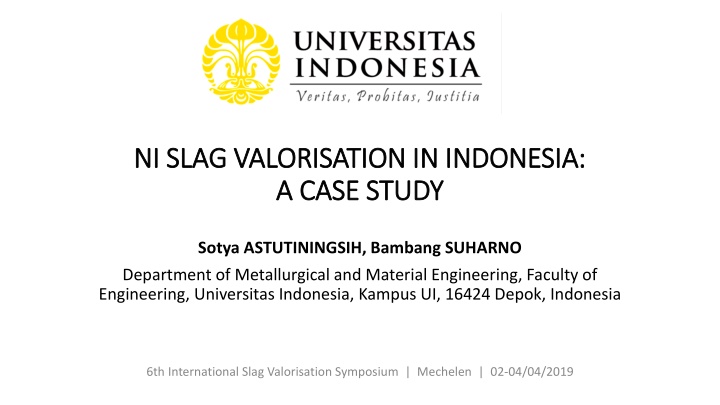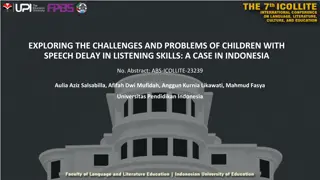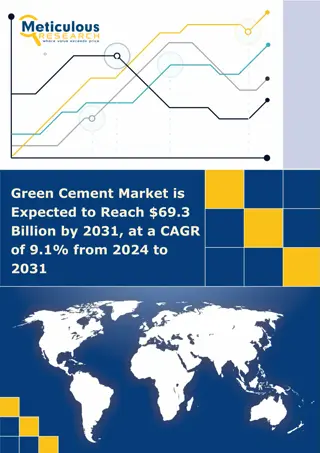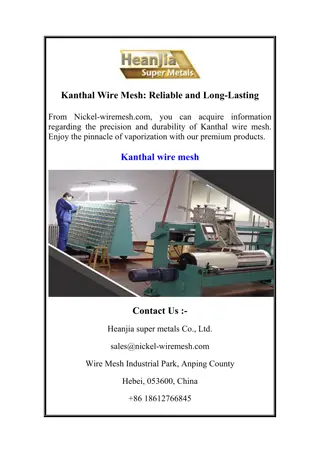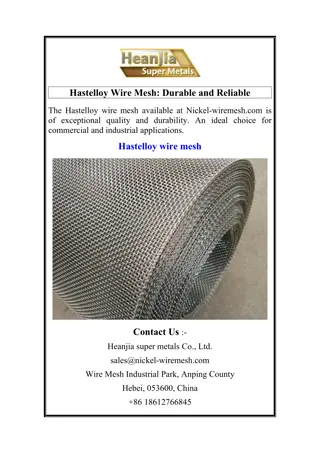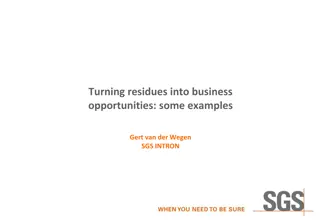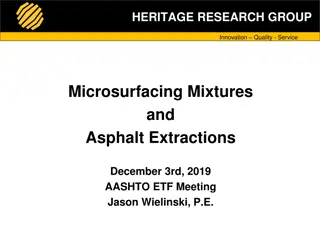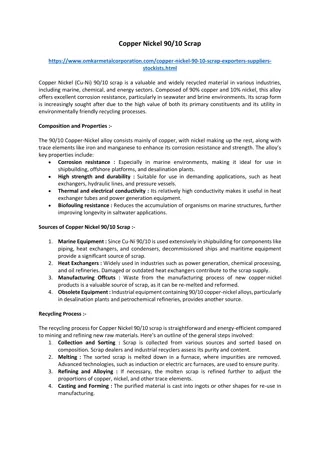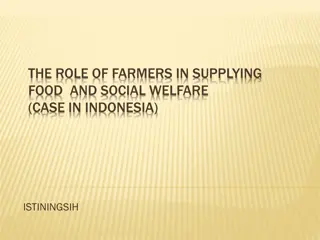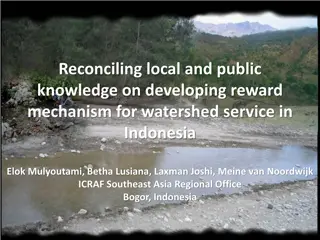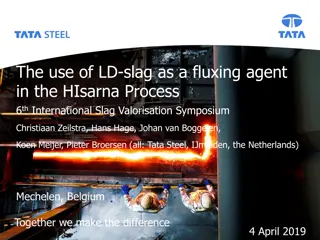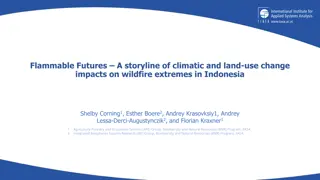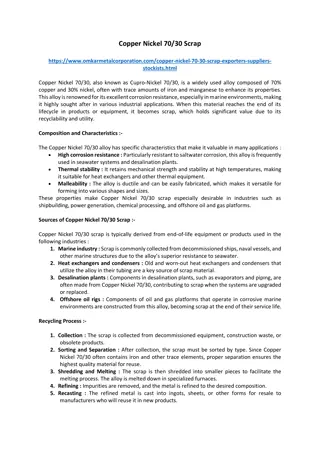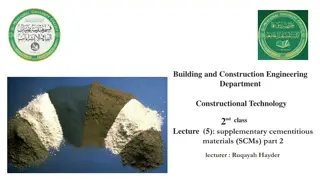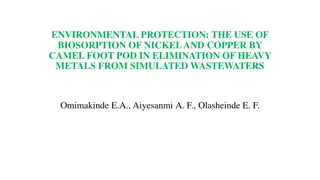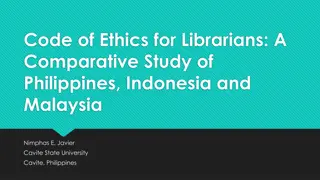Nickel Slag Valorisation in Indonesia: A Case Study
The case study explores the nickel industry in Indonesia, focusing on nickel slag production and valorisation. It discusses the growth and consumption trends in various sectors such as transportation, automotive, household appliances, and more. The utilization of ground granulated blast furnace slag (GGBFS) is highlighted, with a specific company producing significant amounts of GGBFS and electric furnace slag. Efforts are being made to increase GGBFS consumption through applications like inorganic polymer production.
Download Presentation

Please find below an Image/Link to download the presentation.
The content on the website is provided AS IS for your information and personal use only. It may not be sold, licensed, or shared on other websites without obtaining consent from the author.If you encounter any issues during the download, it is possible that the publisher has removed the file from their server.
You are allowed to download the files provided on this website for personal or commercial use, subject to the condition that they are used lawfully. All files are the property of their respective owners.
The content on the website is provided AS IS for your information and personal use only. It may not be sold, licensed, or shared on other websites without obtaining consent from the author.
E N D
Presentation Transcript
NI SLAG VALORISATION IN INDONESIA: NI SLAG VALORISATION IN INDONESIA: A CASE STUDY A CASE STUDY Sotya ASTUTININGSIH, Bambang SUHARNO Department of Metallurgical and Material Engineering, Faculty of Engineering, Universitas Indonesia, Kampus UI, 16424 Depok, Indonesia 6th International Slag Valorisation Symposium | Mechelen | 02-04/04/2019
GAMBARAN INDUSTRI NIKEL INDUSTRIAL SECTOR INDUSTRIAL PICTURE TRANSPORTATION AUTOMOTIVE Consumption: 100.000 tpy Growth 12% py NICKEL ORES Deposit: No. 6 in the world Resources: 3 billion ton Cadangan : 1 milyar ton Production No. 2 in the world(2011). HOUSEHOLD APPLIANCES Growth : 10% py METALS Ferro Nickel production : 180,000 Ton Domestic consumption (stainless steel) : 150,000 Ton 98% Ferro Nickel production supplied for domestic consumption INTERMEDIATE & DOWNSTREAM PRODUCTS MEDICAL DEVICES Simple tools that requires sterilisation Growth 10% py Export 7.200 ton Import 1.200 ton (2012) CONSUMPTION PER CAPITA Stainless Steel: 0.6 kg Target : 1.5 kg (2025) Source: DIREKTORAT INDUSTRI LOGAM DITJEN INDUSTRI LOGAM MESIN ALAT TRANSPORTASI DAN ELEKTRONIKA MINISTRY OF INDUSTRY
6th International Slag Valorisation Symposium | Mechelen | 02-04/04/2019
Nickel slag production per year in some of ferronickel industry, Currently 15 smelters have been operating Ni sla g produced No Company name Tonnes/year 1 PT Trimegah Bangun Persada (PT TBP) 1.000.000 2 PT Aneka Tambang (PT Antam,Tbk) 1.000.000 3 PT Indonesia Morowali Industrial Park (PT IMIP) 7.000.000 4 PT Virtue Dragon Indonesia (PT VDI) 4.000.000 Creation in Added Value
GROWTH JAVA INDUSTRY Slag used throughout this experiment was ground granulated blast furnace slag (GGBFS) supplied by one of Ni smelting industries in Indonesia. This company produced 360,000 TPY ground granulated blast furnace slag (GGBFS) and 300,000 TPY of slag from electric furnace. This company is 1 of 15 Ni smelters operating in Indonesia They already obtained a government permit for GGBFS valorisation, however, only 10% of the capacity is consumed. Consumers of this GGBFS includes Portland cement industry, ready-mix concrete, precast concrete, and mortar industry. To increase the consumption, GGBFS will be used as the main solid precursor for inorganic polymer. 6th International Slag Valorisation Symposium | Mechelen | 02-04/04/2019
a) b) Slag characterization Slag characterization Table 1: Chemical composition of GGBFS Parameter Analysis 1 Wt% Analysis 2 (XRF) Wt% #200* 0.02 n/a 2.78 1.70 24.73 19.40 0.22 9.60 41.18 0.00 0.93 0.2 0.25 1.04 0.66 0.82 n/a n/a Method As-received 0.02 n/a 2.87 1.71 24.71 19.29 0.24 9.69 41.24 0.00 0.90 0.17 0.26 1.07 0.67 0.83 n/a n/a Ni Co Fe Fe2O3 CaO MgO Na2O Al2O3 SiO2 P2O5 SO3 K2O TiO2 Cr Cr2O3 MnO Moisture LOI 0.09 0.02 2.24 3.20 24.83 18.81 0.44 6.23 40.69 0.21 0.37 0.24 0.19 0.68 0.99 0.68 0.22 1.25 XRF XRF By calculation XRF XRF XRF XRF XRF XRF XRF XRF XRF XRF By calculation XRF XRF Gravimetry Gravimetry Figure 2: Scanning electron image of slag particles, with a) of the as-received slag, and b) the slag particles passed #200 sieve. E x = akermanite XRDIbuSotya x xx Counts x 350 10 20 30 40 50 2 theta angle (o) 60 70 80 90 300 Figure 1: X-ray diffraction pattern of the as-received GGBFS 250 6th International Slag Valorisation Symposium | Mechelen | 02-04/04/2019 *particles passed #200 sieve 200 150 100 50
Geopolymerisation Geopolymerisation of Ni GGBFS of Ni GGBFS Figure 3: Compressive strength of geopolymer mortar cured for 24 hours Geopolymer mortar was prepared by mixing GGBFS, quartz sand, and sodium silicate solution. The solution was made from technical grade NaOH, water glass and water. The solution to the powder, i.e. GGBFS and quartz sand, ratio was ~0.33. 6th International Slag Valorisation Symposium | Mechelen | 02-04/04/2019
Figure 4: Compressive strength of geopolymer concrete cured at room temperature The composition of the concrete was approximate, in wt%, 35 coral; 22 quartz sand, 27 GGBFS, and 16 sodium silicate solution 6th International Slag Valorisation Symposium | Mechelen | 02-04/04/2019
Conclusion Conclusion GGBFS from nickel smelting has the potential to be utilized as building materials. Compressive strength of both the geopolymer mortar and concrete were sufficient for use as building materials. The consumption of GGBFS for inorganic polymer is significantly higher than as Portland cement substitutes. The challenge is more to the vast amount of the slag and the supply chain (logistic) of the raw materials to the users. Most of the smelters are located in the island with less population and needs less infrastructure. THANK YOU For your attention 6th International Slag Valorisation Symposium | Mechelen | 02-04/04/2019
